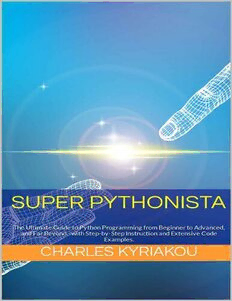Table Of ContentSUPER
PYTHONISTA
The Ultimate Guide to Python Programming from
Beginner to Advanced, and Far Beyond - with Step-by-
Step Instruction and Extensive Code Examples.
Author: Charles Kyriakou
Copyright © 2022 Charles Kyriakou
All rights reserved.
Dedication
This book is dedicated to my supportive and patient wife, Joanne,
and our emotional therapy dogs, Ringo and Harley.
Table of Contents
Table of Contents
Introduction
Chapter 1: Introduction to programming and Python
What is programming?
What is Python?
Why learn Python?
Chapter 2: Setting up a development environment
Why do you need a development environment?
How to set up a development environment
How to set up a development environment in PyCharm
How to set up a development environment in VS Code
Chapter 3: Basic concepts and syntax of Python
Variables
Data types
Operators
Control statements
Chapter 4: Working with lists, tuples, and dictionaries
Lists and list comprehensions
Indexing and slicing lists
Modifying lists
Sorting lists
Tuples and tuple manipulation
Dictionaries and dictionary manipulation
Chapter 5: Working with data types in Python
Working with variables
Working with numbers
Working with strings
Working with lists
Chapter 6: Control structures in Python
Using if statements
Using for loops
Using while loops
Using try and except statements
Using with statements
Chapter 7: Working with files and data input/output
Reading and writing text files
Working with file paths and modes
Reading and writing files line by line
Working with CSV and JSON data
What is CSV data?
Working with CSV data in Python (using the csv module)
What is JSON data?
Working with JSON data in Python
Database connectivity (SQLite, MySQL, etc.)
What is a database?
Connecting to and querying a database in Python
Chapter 8: Writing and using functions in Python
Defining a function
Calling a function
Returning a value
Scope
Argument default values
Variable number of arguments
How to call a function in Python
Using keyword arguments in Python
Using lambda functions in Python
Chapter 9: Working with modules in Python
What are modules?
Importing specific names from a module
Renaming imported names
Importing all names from a module
Creating and using your own modules
Chapter 10: Object orientated programming (OOP)
What is object-oriented programming?
Defining and using classes
Creating and using objects
Inheritance and polymorphism
Chapter 11: Python libraries and frameworks
Introduction to libraries and frameworks
What are libraries and frameworks?
How to find and install libraries and frameworks
NumPy and Pandas for scientific computing and data analysis
What is NumPy?
What is Pandas?
Using NumPy and Pandas for data manipulation and
analysis
Django for web development
What is Django?
Setting up a Django project
Creating a web application with Django
Other popular libraries and frameworks
What is TensorFlow?
What is Pygame?
Using TensorFlow and Pygame in Python
Chapter 12: Debugging and error handling in Python
Common error types and how to handle them
Using the built-in debugger (pdb)
Debugging with third-party tools such as PyCharm and pdb++
Handling exceptions with try-except blocks
Raising and handling custom exceptions
Debugging and error handling best practices
Chapter 13: Development Tools and Techniques
Virtual Environments for Managing Packages and Dependencies
Working with the Python Package Index (PyPI)
Creating and Distributing Python Packages
Using Continuous Integration and Deployment Tools
Performance Optimization and Profiling Techniques
Chapter 14: The Python Inspect Library
Inspecting Modules and Classes
Tips for Using the Inspect Library
Chapter 15: Python and Optimization
Linear Programming with Pulp and Pyomo
Nonlinear Optimization with Scipy
Global Optimization with DEAP and PyGMO
Constraint Programming with Gurobi and Pyomo
Advanced Optimization Techniques with Python
Chapter 16: Advanced Python concepts and techniques
Decorators and metaprogramming
Generators and iterators
Working Asynchronous programming with asyncio
Working with sets, queues, and stacks
Processing and manipulating data with Pandas
Working with databases and SQL
Web development with Flask
Building and deploying web applications
Regular expressions
Chapter 17: Python and Image Processing
Loading and Manipulating Images with Pillow and OpenCV
Filtering and Enhancing Images with Scikit-image
Extracting Features from Images with Scikit-image and OpenCV
Advanced Image Processing Techniques with Python
Chapter 18: Python and Audio Processing
Loading and Manipulating Audio Files with Librosa and PyAudio
Filtering and Enhancing Audio with Scikit-sound
Extracting Features from Audio with Librosa and Scikit-sound
Advanced Audio Processing Techniques with Python
Chapter 19: Python and Video Processing
Introduction to Video Processing with Python
Loading and Manipulating Video Files with OpenCV and
MoviePy
Filtering and Enhancing Video with OpenCV and Scikit-video
Extracting Features from Video with OpenCV and Scikit-video
Advanced Video Processing Techniques with Python
Chapter 20: Python and Desktop Applications
Creating GUI Applications with PyGTK and PyQt
Integrating with External Libraries and APIs
Storing and Accessing Data in a Database
Packaging and Distributing a Desktop Application
Advanced Desktop Application Development
Chapter 21: Python and Web Development
Introduction to Web Development with Python
Building a Web Server with Flask
Working with Templates and Forms
Integrating a Database with a Web Application
Deploying a Web Application to a Hosting Provider
Advanced Web Development Techniques with Django
Building and Deploying a RESTful API with Flask-RESTful
Chapter 22: Python and web scraping
Introduction to web scraping with Python
Using Beautiful Soup to parse HTML and XML
Scraping dynamic websites with Selenium
Handling cookies, headers, and authentication
Scraping data from APIs and data streams
Storing and processing scraped data
Advanced web scraping techniques and best practices
Chapter 23: Python and Data Analysis
Working with Data Structures and Data Types in Python
Loading and Cleaning Data Using Pandas
Exploring and Visualizing Data with Matplotlib and Seaborn

